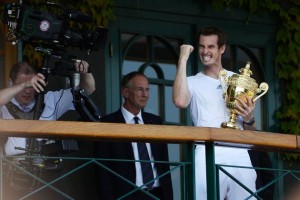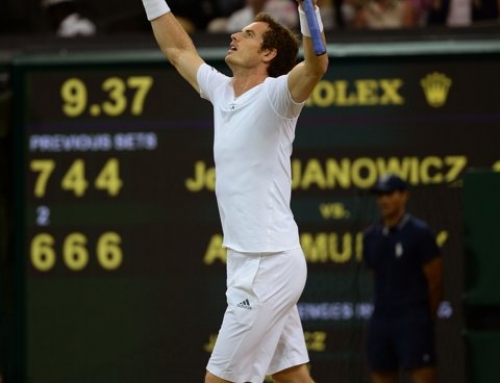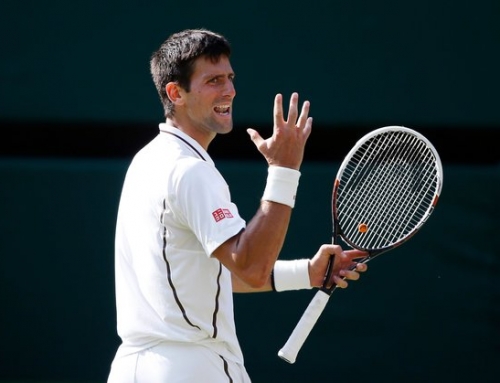1936.
To give a sense of perspective, World War 2 had not started in 1936. Nor had, of course, the Korean War, the Vietnam War, Shock and Awe. It’s certainly possible that Andy Murray’s grandparents weren’t alive when the last British male to win Wimbledon won Wimbledon.
That man, as Andy Murray is constantly reminded, is Fred Perry. In 1936, he won his third consecutive Wimbledon. A British man reached the finals in 1938, but that man, Bunny Austin lost.
Since then, there have been few British men whose skills were worthy enough to contend for the title. John Lloyd never made it past the third round. Tim Henman, throughout the 1990s, was Britain’s best hope and often overachieved. He reached the semis of Wimbledon 4 times, and even the US Open semi, and yes, late in life, a French semi.
But it was typical of British mentality that maybe the Brits were too nice, too polite, and when the chips were down, well, good try, chap. The country felt a collective sigh hoping another year might bring them closer.
Then, came Andy Murray. He wasn’t quite English enough. He was a bit boring in his speech. He played a bit too passively. Andy Murray’s successes quickly eclipsed Henman. He had higher ranking, won more tournaments, even reached a Slam final in 2008 at the US Open.
But, like many British champs, he could never quite get through to the win. He lost to Federer in the 2008 US Open, lost to Federer again in the 2010 Australian Open, then to Djokovic in the 2011 Australian Open. In those 3 Slams, he won 0 sets. He then broke through and reached the 2012 Wimbledon final, and he cracked the first barrier: winning a set, but due to the wet weather, the roof was covered, and this made the event an indoor event, one where Federer excels. His precision strokes are often sent astray in wind. Murray felt the pressure that Federer exerted, but wilted.
Several weeks later, Murray would return back to Wimbledon, this time as a representative of Team GB in the Olympics. He knew how precious this moment was. Few players ever get to play an event in their home country and have a chance for gold. He played an edgy match to beat Djokovic in the semis, then routed Federer in the finals, likely weary from his very lengthy semifinal match against Juan Martin del Potro.
Andy Murray may also have Juan Martin to thank again. The Argentine player that never gives up pushed Novak Djokovic to 5 sets, and it went 5 sets partly because Djokovic started to misfire on his normally steady backhand.
But back to the Slam that got him through. Murray then reached the US Open final. It was a windy US Open, and by all accounts, Murray handled the wind quite well. Tomas Berdych, who had upset Roger Federer on a nice clear evening, struggled with the wind against Murray in the semis. By the time Berdych was starting to come back, Murray managed to cling to a fourth set tiebreak.
The wind seemed to give Murray a nice break as well at the US Open as Murray took the first two sets against Djokovic, but as the wind settled down, Djokovic started to turn up his game as he broke Murray early in the third and fourth sets. It became critical for Murray not to go down a break in the fifth, and he didn’t. He held serve then got an early break. Murray would eventually get a second break and run away with the fifth set and finally get the monkey off his back.
Except.
Except the Brits still wanted him to win on home soil. Murray had an injury at Rome which turned out to be a blessing in disguise. His back was bothering him in a match against Marcel Granollers. He fought hard enough to win a set, then retired. He announced he would skip the French Open to recover and get ready for Wimbledon. Murray has always struggled on clay, and the kind of movement he needs for clay often aggravates the injury.
By that point, Murray has been match shy, so he made an effort at Queen’s Club and won the title with a win over Tsonga in the semis and Cilic in the finals.
When the draw came out, Murray’s side of the draw looked dire. He had Federer and Nadal in his half, though to be fair, because of Nadal’s fifth seeding, and the random jumble of the ping pong balls, Nadal and Federer were in the same quarter. Then, came disaster number 1. Rafael Nadal, after winning a record 8th French Open, decided not to play a grass event, and there were some thoughts that maybe, despite playing only one hardcourt event all year, that Nadal’s knees were acting up again, and that he would need to take a lot of rest which meant little practice.
Nadal is a creature of practice. Without constant practice, Nadal doesn’t feel confident hitting to the lines. That, and Nadal is often at his most vulnerable in the opening rounds of a tournament when he’s yet to get his rhythm. Steve Darcis, like Lukas Rosol, played the match of his life, clinching two close tiebreaks, and then taking the third to knock Nadal out of the first round.
That left Federer’s path to the semi wide open. Except Federer fell victim to Bloody Wednesday. While Murray had a nice easy win over Yen-Hsun Lu, Federer was to lose to Sergey Stakhovsky, who served and volleyed his way to a win, surprising Federer time and again. Once upon a time, Federer would have known how to handle a serve and volleyer–indeed, his game was serve and volley on grass. But given how few players play that style, Federer was struggling to come up with pass after pass, and eventually resorted to trying to hit Stakhovsky. It wasn’t enough, and Federer dropped out of the tournament with a loss.
And despite Murray having a pretty good record against Tsonga, it was also nice that Tsonga had to bow out against Gulbis with an injury.
When three of his biggest rivals failed to make it out of the second round, Murray’s half of the draw became a lot easier, and many a British fan felt there was no reason he couldn’t make the finals.
Murray met two veterans in successive rounds, Tommy Robredo and Mikhail Youzhny, and got past both without dropping a set. Then, he faced a resurgent Fernando Verdasco whose ranking had slipped as had his confidence. A new coach and a new racquet, and Verdasco was winding back the years, taking the first set in a close tussle then watching Murray melt in the second set, but then Verdasco’s mental frailty began to show as fatigue set in. Murray took the third set easily, the fourth set with a late break, and then had to play great games to break and hold, and get out of a mess that could have spelled defeat for the resilient Scot.
In the semifinal, Murray faced surprise semifinalist, Jerzy Janowicz, a 22 year old Pole, 6’8″ with a huge serve and a huge forehand and a deft touch. He came out of the gates firing serves, forehand and drop shots. Murray played a poor first set tiebreak to give up another set, but got a break in the second set, and closed that. He dropped his serve in the second set, and was down 4-1, before he bulldozed his way to 5 straight games and the third set. The referees decided that the roof needed to be closed so they wouldn’t have to interrupt the match in the middle of a set. Murray was irate and livid, but won the fourth set quite handily breaking early, then late to reach the finals.
For the finals, Murray had to hope that Djokovic might be off his game, and just as wind had helped him win the US Open, it turned out heat was the key at Wimbledon. Once upon a time, a hot day would have spelled doom for Djokovic who, prior to his gluten free diet, struggled when it got hot and had frequently retired. Even so, given the cool weather at Roland Garros and the cool start of Wimbledon, a mid 80 degree temperature was positively balmy.
Murray’s strategy was to play long rallies against Djokovic testing his fitness, and unlike the Australian Open where Murray had only 4 break points and converted none, Murray was contesting Djokovic on nearly every serve. Murray achieved a break early on, but was broken back, and that left the British crowds wondering if this was leading to another disappointment. But Murray had another break, and was able to close out the first set. A key to Murray’s win was avoiding breaks.
The long rallies, even early on, seemed to take a toll on Djokovic, and it seemed like the heat would do him in. Djokovic began striking the ball more aggressively, which meant Murray was forced to do more running, and play defense.
The second set started better for Djokovic who looked like he had recovered from the heat. He broke to get up 3-1, then held for 4-1, but unlike previous attempts by Brits, Murray was willing to fight back. He held, then broke, then held to bring it to 4-all. The two went to 5-all. Djokovic had run out of challenges in the middle of a set, and yelled at Lahyani about a slice backhand that Djokovic thought was surely out (replays show it wasn’t). Murray then broke again and held for the second set.
With a two set to none lead and Djokovic seemingly rattled, it felt like Murray might win the third set in a cakewalk. This was buoyed by an immediate break that allowed Murray to get to a 2-0 lead. Djokovic wasn’t going away so soon and broke back twice, and reached a 4-2 lead, and it seemed, once again, that there might be a long battle ahead. However, as he had in the second set, he broke and broke again, and was ready to serve for the championship, 5-4 up. Much of the last break had to do with Murray reaching drop shots that Djokovic was throwing feeling Murray was vulnerable in his movement, and Murray finally catching up to them. It may have helped that he played Janowicz and had to chase down a lot of drop shots.
And, then Murray went up 40-0 up, and with triple championship point, it seemed the long wait was over, but that last game became Britain’s woe tied up in a single game. Djokovic played a wonderful point at net, hit an aggressive return, then Murray made an error with the backhand, and it was deuce. Murray would net a shot to break point, and all of a sudden, Great Britain, on the cusp of lifting a big monkey off their back were left gasping. Murray would hit a big serve to get it back to deuce.
Djokovic would get to net and hit a half volley to get another break point. Murray would save that break point too. But Djokovic won another point and reached his third break point. This time Murray played some aggressive shots and saved break point and reached one more championship point. Murray hit a nice serve, but Djokovic returns it deep. The crowd thinks it’s going long, but it goes in and Murray hits it deep inside out to the Djokovic backhand, and finally, Djokovic nets the down the line shot, and Murray has sealed it.
So how did Murray win it? Part of it was serving a bit better than Djokovic. Second was the heat which bothered both Murray and Djokovic but probably had a bigger impact on Djokovic who wasn’t as sharp as he wanted to be. Third, Murray just fought and fought and gave himself opportunities. He played less aggressive than Djokovic, but played big points when he needed to. He also used the slice to keep him in points as he had done in the previous two matches. Also, he generally did well on passes and hit his forehands big when pulled out wide.
 And by winning his second Slam, he moves himself out of the one Slam wonders. Like Lendl, it’s rare for someone to keep reaching Slam finals and not win a few. Lendl ended up with 8, though he peaked right between McEnroe and Connors on decline and before the rise of Becker and Edberg who he still could beat. Lendl lost more Slam finals than he won, but still reached plenty of finals. Murray, by contrast, was not nearly the kind of aggressive player Lendl was, so he’s managed to do well despite not being an offensive juggernaut.
And by winning his second Slam, he moves himself out of the one Slam wonders. Like Lendl, it’s rare for someone to keep reaching Slam finals and not win a few. Lendl ended up with 8, though he peaked right between McEnroe and Connors on decline and before the rise of Becker and Edberg who he still could beat. Lendl lost more Slam finals than he won, but still reached plenty of finals. Murray, by contrast, was not nearly the kind of aggressive player Lendl was, so he’s managed to do well despite not being an offensive juggernaut.
Under Lendl, Murray has reached 4 Slam finals including the last 4 he’s been part of (Wimbledon, US Open, Australian Open, and Wimbledon) which is a step up from where he had been (mostly reaching semis if he got that far).
So Great Britain, the long wait is over. The Scot has won Wimbledon, and you can now relax.






![[Wimbledon, QF] Murray scraps out 5-set win over Verdasco to reach semifinals](https://www.essentialtennis.com/wp-content/uploads/2013/07/20130703murray-500x383.jpg)
![[Wimbledon, Day 3] Federer’s 36 Slam quarterfinal streak ends with 2nd round loss to Stakhovsky](https://www.essentialtennis.com/wp-content/uploads/2013/06/20130626stak-500x383.jpg)